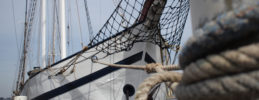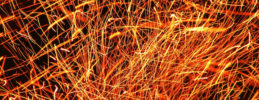
('Light Lines' © Nathan Harper, 2008)
WRITER’S ROAD TRIP: TRAVELING THE EXTERIOR AND INTERIOR LANDSCAPE
by PATRICIA ANN MCNAIR
As a writer and lover of short stories, and as a long-time teacher of creative writing, I have come to realise that we all have material worthy of story making, derived from some combination of memory, imagination and observation. When a student says they don’t have anything to write about, or when I get stumped myself, I know that it is not content we yearn for: it is structure. We all have stuff to fill our story vessels with, but sometimes, we need help finding a vessel. And often the shape of the vessel will help us determine what we want to fill it with.
One of my favorite structures is what I call ‘The Writer’s Road Trip’. This specific exercise is a version of something I tried myself after seeing a number of short stories (and other narratives) that include a brief trip. Now I often use this structure in my own work (‘Running’, from The Temple of Air, for example), and I enjoy finding it in the work of others (‘The End of Firpo in the World’, by George Saunders and Roddy Doyle’s ‘Recuperation’ come to mind.) This exercise is designed to offer a structure from which we can find and make a narrative movement.
Here’s how it works:
Start with a trip in mind that you or a character might take. For the best results the trip should be relatively short (a daily walk, a four-hour drive, a marathon) as opposed to a six-month backpacking excursion or the like. (Know, though, that this structure might work for that narrative as well, but will take much longer to write.) It can be a once-in-a-lifetime trip, an ordinary, everyday errand, or anything that feels like it will give you more to discover or understand.
The traveler is likely solo, but if not, they should be in a position to be alone in their head when needed. The trip provides an exterior landscape that evolves as the traveler passes, and as time passes. The time passing allows the traveler opportunity to reflect, and to move about the interior landscape as well. The writing ‘on the road’ will provide a forward movement for the story, a chronology and foundation from which you can diverge on occasion to build more than a straight (and narrow) line of narrative.
For the purpose of the activity, the following steps will provide a ‘map’ for the narrative. Writing on your own, use whatever parts of this you want in whatever order, or just see what exploration and discovery following the steps closely might provide for further writing. Whenever possible, throughout the writing, render fully realised scenes and interactions.
ON THE ROAD steps are meant to move the story and the journey forward through the external landscape.
PULL OVER steps are meant to deepen the narrative, often through an awareness and exploration of internal landscape (memories, thoughts, worries, understandings.)
1. ON THE ROAD. Get the trip started. No backstory, no setup. Get your character(s) on the road. See the place as the character passes through. Time of day, place, weather, etc.
2. PULL OVER. Take a moment to tell the purpose of the trip. Where and why are they going?
3. ON THE ROAD. Continue on the forward track. Don’t forget sensory details—sights, sounds, smells, textures, tastes. What attracts your traveler’s attention along the way?
4. PULL OVER. Tell a memory triggered in this moment by this trip.
5. ON THE ROAD. Continue on the forward track. Has anything changed or does it seem different? It doesn’t have to, but it might. Perhaps because of the memory just told.
6. PULL OVER. Create an encounter. Another traveler? An animal? Something in the landscape? What is the scene?
7. ON THE ROAD. Continue on the forward track. What is different? What is the same? Has the movement changed in any way? What do you notice about the landscape now?
8. PULL OVER. Tell another memory.
9. ON THE ROAD. Get your characters moving again.
10. ROAD BLOCK! Create an obstacle. Big or little, something that impedes the forward momentum.
11. ON THE ROAD. Let the weather have an effect different from what has come before. Rain? Tornado? Darkened sky? Too much sun? Storm? All of a sudden, the perfect day?
12. ON THE ROAD. Continue in this weather system. How does it change the progress? Does it? Is there a memory here to help create tension or depth?
13. JUMP WAY AHEAD. What does the traveler anticipate after s/he has arrived?
14. ON THE ROAD. Pick up the movement from where you left off on step 12.
15. DESTINATION. Where has the character arrived at—externally and internally?
A reminder that you need not follow these steps in any particular order, or at all, for that matter. But consider what you can learn about your characters when you travel with them: their wants and desires, their tenacity to overcome obstacles or not, the discoveries the landscape (external and internal) can present. And a trip like this gives you a solid structure to build your story. Trips start and trips end, and a lot of stuff happens in the middle. Just like good short stories.
‘For my part, I travel not to go anywhere, but to go. I travel for travel’s sake. The great affair is to move.’ –Robert Louis Stevenson
~
 Patricia Ann McNair’s essay collection, And These Are the Good Times, is a finalist for the Montaigne Medal – Hoffer Award as the most thought-provoking book of 2017. Her short story collection, The Temple of Air, received the Chicago Writers Association Book of the Year Award, Southern Illinois University’s Devil’s Kitchen Reading Award, and the Society of Midland Authors Finalist Award. McNair’s fiction and creative nonfiction have appeared in various anthologies, magazines, and journals including Solstice, American Fiction: Best Unpublished Short Stories by Emerging Writers, Superstition Review, Word Riot, Hypertext, Prime Number, River Teeth, Fourth Genre, Brevity, Creative Nonfiction, and others. She teaches in the fiction and nonfiction programs at Columbia College Chicago.
Patricia Ann McNair’s essay collection, And These Are the Good Times, is a finalist for the Montaigne Medal – Hoffer Award as the most thought-provoking book of 2017. Her short story collection, The Temple of Air, received the Chicago Writers Association Book of the Year Award, Southern Illinois University’s Devil’s Kitchen Reading Award, and the Society of Midland Authors Finalist Award. McNair’s fiction and creative nonfiction have appeared in various anthologies, magazines, and journals including Solstice, American Fiction: Best Unpublished Short Stories by Emerging Writers, Superstition Review, Word Riot, Hypertext, Prime Number, River Teeth, Fourth Genre, Brevity, Creative Nonfiction, and others. She teaches in the fiction and nonfiction programs at Columbia College Chicago.

